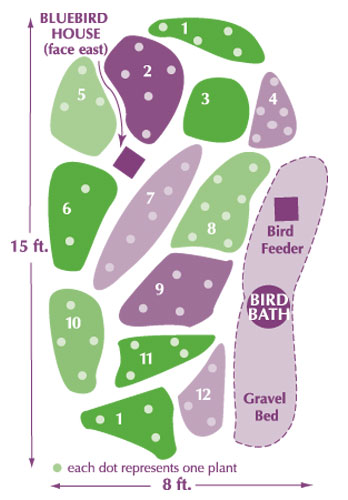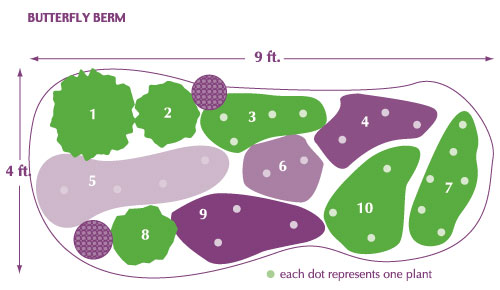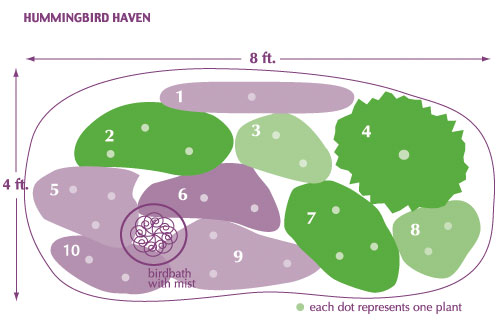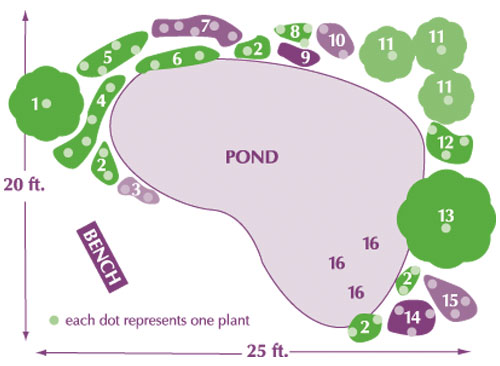Well-designed native landscapes create eye appeal and attract watchable wildlife to your yard. Wildlife species evolved with their favorite native plant species and prefer them for food and shelter. For design ideas, take a look at these diagrams and adapt them to fit your needs. While your space may be smaller or larger, the plant palette for attracting certain species of wildlife remains the same.
Finch Feast
The finch feast is a wildlife-themed garden that concentrates on fruiting trees, shrubs, perennials and grasses with seed heads. Add a birdhouse, birdbath, or feeder for even more attraction.
Legend
- Prairie dropseed
- Purple coneflower
- Rose verbena
- Missouri primrose
- Showy goldenrod
- Eastern gama grass
- Prairie blazing star
- Orange coneflower
- Blue false indigo
- Grey-headed coneflower
- Lanceleaf coreopsis
- Purple poppy mallow
Note: plant in sun, but near one or more fruiting shrubs or small trees to provide food, cover and nesting.

Butterfly Berm
The butterfly berm is an easy family project with colorful, nectar-rich natives such as New Jersey tea, prairie blazing star and butterfly weed. Add a shallow saucer or old birdbath filled with sand, gravel and water for a butterfly “watering hole.” Berms in general are good design elements for an urban or suburban yard. These independent beds can be created in a day or a weekend by adding a low mound of topsoil. It’s best if there is no vegetation growing in the area where the berm will be placed. This gives you an immediate clean slate, and the slight elevation really sets off plants.

Legend
- Buttonbush
- New Jersey tea
- Rose verbena
- Purple coneflower
- Aromatic aster
- Prairie blazing star
- Butterfly weed
- Lanceleaf coreopsis
- Downy phlox
- Shining blue star
Purple circles represent butterfly watering holes.
Hummingbird Haven
The hummingbird haven is similar to the butterfly berm. It concentrates on masses of nectar-producing flowers of various, vibrant hues including blue sage, yellow honeysuckle, foxglove beardtongue, cardinal flower and red buckeye. The addition of a hummingbird feeder or water mister can keep the ruby-throated wonders around from mid-spring to early fall.
Legend
- Yellow honeysuckle (on trellis)
- Royal catchfly
- Blue sage
- Red buckeye
- Columbine
- Wild bergamot
- Garden phlox
- Foxglove beardtongue
- Purple beardtongue
- Rose verbena
Fountain mist in birdbath allows hummers to clean their feathers.

Frog Pond
If you want a perennial water feature, you might install a small frog pond edged with dazzling cardinal flower, blue lobelia, pickerel plant and wild canna. A fringe of tussock sedge and southern blue flag completes the design. These natives also flourish in boggy, damp areas — or ones with heavy, wet and clay soils — where many other species cannot survive. Your frog pond can be made with a pre-formed or sheet liner, but one with a simple clay bottom will allow amphibians to over-winter.
Legend
- Buttonbush
- Tussock sedge
- Swamp milkweed
- Downy skullcap
- Cliff goldenrod
- Pickerel plant
- Blue lobelia
- Garden phlox
- Southern blue flag
- Silky dogwood
- American beautyberry
- Golden ragwort
- Ninebark
- Cardinal flower
- Copper iris
- Water canna






















